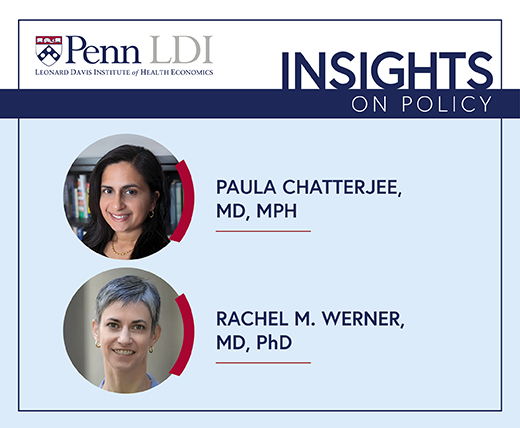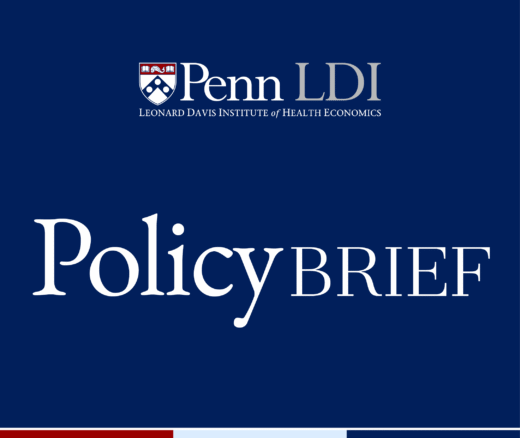
Analysis of the Rural Health Transformation Program
Memo: Response to Request for Analysis
Population Health
News
While it’s widely understood that income levels directly influence an individual’s or family’s long-term health and health outcomes, the 2021 Child Tax Credit (CTC) expansion highlighted this connection more clearly than ever. As part of the federal American Rescue Plan Act in response to the COVID-19 crisis, the temporary one-year expansion nearly doubled the credit per child and made it fully refundable—allowing families with little or no federal tax liability to receive the full amount. It also introduced monthly payments rather than a lump sum at tax time, offering consistent support throughout the year. Additionally, expanded income thresholds made the benefit accessible to more families.

“For the first time, the 2021 CTC provided cash to families at the bottom of the income distribution,” said Elizabeth Ananat, PhD, a Professor of Women and Economics at Barnard College at Columbia University and a former Senior Economist for Labor, Education, and Welfare on the White House Council of Economic Advisors. “We know that food insecurity fell dramatically, particularly among the lowest-income families. We also saw that when kids were born to moms who had older children and were receiving CTC payments while they were pregnant, there were improvements in newborn health. This was evidence why fiscal policies directed at the lower end of the income distribution seem to be important for family nutrition and health.”
Ananat was speaking at the March 28 “Boosting Health Through Economic Policy: Tax and Labor Policies to Improve Population Health” virtual seminar of the University of Pennsylvania’s Leonard Davis Institute of Health Economics (LDI) and Penn’s Opportunity for Health (OfH) Lab. The event featured four top experts: Moderator LDI Senior Fellow Atheendar Venkataramani, MD, PhD, Director of the OfH lab; Ananat; Bradley Hardy, PhD, MPP, a Professor at the McCourt School of Public Policy at Georgetown University; and Aparna Mathur, PhD, Visiting Fellow of Labor Economics at the Research on Equal Opportunity Foundation (FREOPP) and former Senior Economist on the White House Council of Economic Advisors.
The discussion ranged across topics including state and federal tax credit programs, unemployment insurance, benefits unclaimed by qualified individuals, the changing dynamics of low-wage American jobs, the need for worker upskilling programs, and a call for a centralized national hub approach to matching individuals and families with appropriate economic assistance programs.
Launched in 2020, the OfH Lab’s research is focused on the intersection of state and federal fiscal policy and population health. It identifies and evaluates interventions and policies that can potentially boost economic stability and opportunities, particularly for low-income individuals and families. And it does this in the context of the broad body of research evidence correlating income levels with health and health outcomes.

The Centers for Disease Control and Prevention (CDC) has explained: “There is a well-established relationship between income and health, especially between poverty and poor health. Income can influence people’s risk for chronic diseases such as heart disease, diabetes, and stroke. Additionally, low-income families often lack access to health insurance, safe communities, healthy food, and physical activity facilities, all of which are critical for maintaining good health. Financial stress and insecurity associated with poverty also negatively affect health.”
The consensus of the seminar participants was that federal tax credit programs—the CTC and the Earned Income Tax Credit (EITC)—along with the supplemental tax credit programs offered by a number of states are among the most powerful economic assistance programs that help boost family income and health, but they’re not perfect or completely equitable in their effects.
“Given that incomes among Black households tend to be far lower on average than those of white households, it’s no surprise to think that health outcomes are going to be worse for Black individuals and households,” said Hardy, a nonresident Senior Fellow of Economic Studies at the Brookings institution. “But differences in income don’t fully account for the differences in health outcomes we observe across race. For example, recent data from California demonstrates that differences in health outcomes by race are really greater than those by socioeconomic status.” He pointed to research showing that even among the wealthiest Black families in California, maternal and infant health outcomes—such as rates of preterm birth, low birth weight, and severe maternal morbidity—are worse than those of the poorest white families.

Venkataramani noted that a recent article in the Journal of Economic Perspectives analyzes the safety net’s dynamics since 1996 found that various economic supports have increased for working families but declined for individuals without earnings, raising the question of what is the appropriate trade-off between promoting work versus preventing material hardship?
“The biggest hole in the safety net is for those adult individuals without dependents and without earnings,” Venkataramani said. “So, the interesting development is that there’s potentially a larger safety net than ever before, but it is targeted in a very specific way.”
Mathur agreed. “We still don’t have a federal policy which really reaches the lowest wage workers on unemployment insurance,” she said. “That insurance program is designed to support you when you lose your job or encounter an economic crisis. But what we find across the U.S. is that only about 40% of unemployed people at any given point in time are actually taking advantage of unemployment insurance benefits. A big reason for this is complicated eligibility rules. This is not unusual in the safety net. Looking back at the Earned Income Tax Credit program, which is a really beneficial one, only about 78% of eligible families actually take it up. We really need to be talking about how to fix this.”
She went on to explain a large part of the problem is that parents don’t understand what the phrase “qualifying child” means. And that seemingly simple phrase at times isn’t so simple.

“You have situations where the parents are separated and the child is spending four months here, six months there and elsewhere,” Mathur said. “That’s when rules related to making EITC claims become really complicated. There are income limits, asset limits, and family size issues that define how much you can claim. Some people are worried about claiming it on their tax filing for fear of making a mistake and having to deal with the IRS.”
Similar behaviors are documented across the top ten benefits programs like Temporary Assistance for Needy Families (TANF), the Special Supplemental Nutrition Program for Women, Infants, and Children (WIC), Supplemental Nutrition Assistance Program (SNAP), the Section 8 Voucher Program, and others.
“If you look at the Survey of Income Program Participation (SIPP), which is the best household survey on benefit usage, it’s just shocking,” said Mathur. “A third of the people who are 130% or more below the federal poverty line, are not claiming these big benefits. Another third is only signing up for 1 or two, even though they qualify for more. A big reason for this is administrative burden. In some ways, we make it really hard for people to claim these programs that we think we’re spending a lot of money on.”
Another aspect of the issue may be the way the benefit policies and programs have in recent decades failed to recognize and adjust to dramatic changes throughout the labor market.
“I think a lot of professional people have an inaccurate sense of what a low-wage job is like. They’re thinking of the manufacturing past when it was all factory shift work,” said Ananat. “A lot of low-wage jobs today are hourly and customer-facing retail, food service, and hospitality markets that are very volatile. Individuals are expected to be always available for work but only get paid when needed. In bad weather or low customer traffic days, they’re sent home. Or they’re working multiple part-time jobs. Nearly 40% of low-income parents work these kinds of jobs now, experiencing a lot of fluctuations in their hours and weekly earnings. This, in turn, makes it difficult for them to stay enrolled in support programs that require that they constantly report their earnings and changes in earnings. This kind of volatility is very stressful for families to manage.”
Ananat described a related common problem of the child custody requirements in the tax credit programs. “Imagine that you have an opportunity to earn some more money by doing overnight inventory, so you split custody with your kid’s other parent,” Ananat said. “But then maybe you send the child to the grandparents for a week so you can take advantage of other extra hours and, as a result, you fall well below the days of custody required to claim EITC or CTC. These are just some of the ways the support programs and policies haven’t adapted to the new realities of low-income jobs.”
Zeroing in on what seemed an obvious solution, Mathur called for a government “one stop shop” where a low-income individual could sign in to provide details of their income, assets and other personal data, and be told what programs like TANF, WIC, SNAP, Section 8 and others that they qualify for.
“The government should be reducing the administrative burdens, helping people learn about the various support programs they qualify for and providing all of those benefits in an easily accessible form,” said Mathur.
“The biggest challenge in the future is going to be how these technologies we see rising all around us are going to affect the work that employees are already doing,” said Mathur. “I think greater support for retraining or upskilling for low-wage and other workers is going to be important. We really need to focus on this it’s a place where we can make the biggest difference.”
Hardy pointed to the need for a region’s anchor employers to work with community college systems to create a very targeted curriculum that can effectively train and prepare workers for the new skills that local industry requires. “My sense is that here in the U.S. we probably invest less in these types of programs than other OECD large economies,” he said.
In a country comparison of a different sort, Ananat emphasized that the U.S. culture’s “nose-to-the-grindstone-no-matter-what” work ethos may be crippling its efforts to modernize economic assistance policies and programs. “Other countries are a little more comfortable with people not being so focused on keeping the unemployment rate so low at every moment,” she said. “One thing that was really interesting during the COVID-19 pandemic when large numbers of people were getting non-labor economic assistance income was how many spent that money on retraining or starting businesses. They had enough money to pay their bills and invest in their own future through upskilling and thinking outside the 9-to-5 grind box about other kinds of earning opportunities. What we saw by the end of the pandemic was the greatest explosion of small businesses in decades.”
According to the U.S. Bureau of Labor Statistics, between 2020 and 2023, there was a record 56.7% increase in the numbers of applications (20.7 million) filed with the U.S. Government to register new businesses.
As the session drew to a close, Venkataramani asked the panelists to name one of the most interesting new ideas about economic assistance programs currently being discussed in their professional circles. Here’s what they said:
Mathur: “We’re used to thinking about work and jobs in a certain way but there’s a tremendous amount of uncertainty about what that will look like in the future. Irrespective of how jobs play out, people are still going to need food, education, health care and other things. One idea gaining steam is something like a portable savings account or benefit that a person, an employer, and the government contribute to. These savings, in turn, can be used in at any given point in life for things like new training or skills certification, or a health care need. At challenging times, it guarantees a person some basic income support not directly attached to work.”
Ananat: “A different approach would be a permanent version of 2021 child tax credit (CTC) that provides a bit of money regardless of whether a person has had a high-earning month or low-earning month, or a month with job loss. We now know that the 2021 CTC actually resulted in some people working more. It helped them invest in childcare, or get a car repaired, or take a class, or start a business. Giving people some non-labor income with no strings attached during challenging times actually helped them work more, even though that does fly in the face of the labor ethos in this country. That ethos undersells a lot of Americans who want to make an investment in themselves but can’t afford to.”
Hardy: “In the Hamilton Project at Brookings, I was in a team looking at so-called “able-bodied adults without dependents” or “ABAWDS.” There is not much government support for these adults and there is very little in the way of poverty reduction they experience from government support programs that aren’t targeted at them. Many have work-limiting disabilities. They face health challenges. Almost 40% are parents. I think there’s an opportunity to deliver some assistance to this group. I think this is one area that calls for reform.”


Memo: Response to Request for Analysis

Lessons from the Past, Imperatives for the Future

A New Study of a Sample of Facilities Found Half Without Any Behavioral Health Staff

Physicians Were Paid About 10% Less for Visits Involving Black and Hispanic Patients, With Pediatric Gaps Reaching 15%, According to a First-of-Its-Kind LDI Analysis

A New Review Finds Hospital Mergers Raise Prices Without Improving Care, and Urges Regulators to Stop Accepting Quality Claims to Justify Consolidations

Technology Helps Older Adults Stay at Home—But May Delay Necessary Transitions to Higher Levels of Care